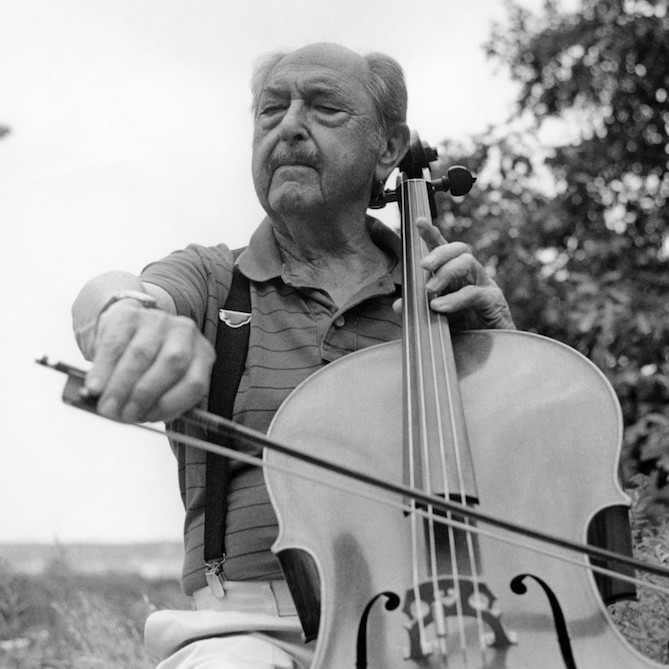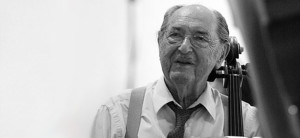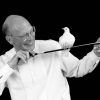
Speaking and Singing: Bernie’s Use of Musical Rhetoric, and his Link with Casals
Steven Doane
My introduction to Bernie’s wonderful sound and magical phrasing came from hearing a recording of the slow movement of the Fauré piano Trio by the original Beaux Arts Trio. I was simply transported, both by the music and the playing. It was towards the end of my undergraduate studies at Oberlin, and the thought came to me quite simply: “I must study with this man!”
Bernie’s playing had that special ability to speak directly to the heart of the listener. It wasn’t just the ravishingly beautiful sound he made (although that had a considerable effect!!) but his way of shaping the line so completely—it was sung and sometimes “spoken” at the same time! As an admirer of Casals from a very young age, I think I must have recognized something familiar in that wonderfully lyrical yet clearly “enunciated” style of playing, channeled as it was through Bernie’s uniquely beautiful sound.
As a kid from Michigan who worshipped Casals in the 60s, I’d tried to get to the “Master” for some kind of lesson, master class or other encounter since I was 17, and even got a sweet letter from Martita Casals letting me know it wasn’t so easy to arrange! So for the time being I decided to pursue his disciples, and the first of those who I managed to work with in 1969 was Maurice Eisenberg, Casal’s close friend from the war years in Paris (who was at that time on the faculty at Juilliard). Eisenberg was giving summer Classes in Cascais, Portugal, along with violinist Sandor Vegh. Casals had obviously had a huge influence on both musicians, and Eisenberg’s sound concept and approach to cello technique reflected that.
It wasn’t until I had finally met and played for Casals at Marlboro a couple of years later, and was completing my studies at Oberlin with the wonderful Richard Kapuscinsky that I was lucky enough to get a scholarship to work with Bernie in the MM program at Stony Brook. It was there that I got to know more about his playing and teaching at close quarters.
The Music Dept. at Stony Brook was still in a formative stage, and our lessons took place in classrooms in the humanities Department. But if the setting was a bit hap-hazard, the inspiration of Bernie’s playing wasn’t! I was at a pretty awkward stage as a post-grad student, and trying to figure out a number of issues in my playing. The complete naturalness of Greenhouse’s approach to the cello was both amazing (and occasionally almost exasperating!) to observe first-hand. There was a deceptive simplicity to his approach—tremendous economy of motion and gesture, and with no overtly obvious connection for me at first to the sublime results. I ended up, I realize, trying to “decode” what was happening when those hands moved about the cello in a very calm, and sometimes amazingly deliberate choreography…
Bernie’s playing and his priorities as a teacher when I was working with him were wonderful examples of a truly ‘vocal” approach to phasing. He always stressed the importance of the singing line produced by the bow (his inimitable sound of course a product that impulse, and also possibly influenced by his work with Felix Salmond, among others, who had a unique quality to his sound production). He often stressed the “speaking” or rhetorical quality that the left hand action contributed within the phrase, in a way I hadn’t encountered before. In lessons he spoke of developing a “walking” sensation from one finger to the next, and in his demonstrations showed us a wonderfully subtle variation of both articulation and vibrato width within a phrase—in general increasing the width of the vibrato as one approached the phrase peak, and reducing it as the phrase subsided.
What I found completely wonderful in his demonstrations was not only this control of musical nuance, but the subtle control of impulse and release in the left hand which made this possible. There was a complete release of tension in his playing from one finger to the next—allowing the hand to maintain it’s beautiful equilibrium and balance from note to note uninterrupted, and allowing complete freedom of musical expression. In addition, the bow’s action was undisturbed by any sudden or unbalanced movements—something I was struggling with at the time! The principle of articulation and release which is so audible in Casal’s playing, and which gives the older master’s work such remarkable clarity, was something I believe Bernie had successfully absorbed into his own work. As a great continuo player for so many years in the Bach Aria group, I’m sure he also had a heightened sense of musical “rhetoric”, and this must have also made a significant contribution as well.
The beautiful simplicity of Bernie’s bowing style was elusive, but completely memorable! The change from down to up at the tip was amazingly economical, and I can only now, years later, compare his seamless changes of bow from up to down at the frog as an infinitely varied “wave” action, with the flow of energy down the arm to the hand being released by the “gently breaking wave” of the fingers at the bow change.
I do remember a wonderful visit Bernie made to Eastman for a master class some years ago. He was seated in one of our smaller recital rooms demonstrating his wonderfully fluent shifting technique, his somewhat portly form seated before us and his hand seeming to simply float effortlessly up and down the fingerboard, in a counterpoint to his bowing. Having puzzled through what I knew must be happening behind the “magic screen” of these wonderfully balanced motions, I asked him to turn his back to the audience of young cellists to repeat this series of maneuvers. He was happily delighted to oblige, and when he did so, we could see the amount of movement he used to facilitate this from his back; his beautifully tailored suit coat expanding and contracting around the shoulder blades almost like a magic bellows, to support the seemingly effortless action of his arms and hands.
To sum up, Bernie was not only an amazing musical model and mentor, but a wonderfully kind human being, who took enormous pleasure in the accomplishments of his pupils. He is greatly missed, but the inspiration of his beautifully playing remains with all who heard him or had the good fortune to study with him!
 A member of the cello faculty at the Eastman School of Music since 1981, Steven Doane has earned an international reputation both as performer and teacher. Formerly principal cellist of the Milwaukee Symphony and Rochester Philharmonic, and a member of the Naumburg Award-winning New Arts Trio during the 1980s, Mr. Doane has since built a performance career as concerto soloist, recitalist and chamber musician. Currently a member of the Los Angeles Piano Quartet, he has also participated in several period instrument performance projects with the Smithsonian Chamber Players in Washington, D.C.
A member of the cello faculty at the Eastman School of Music since 1981, Steven Doane has earned an international reputation both as performer and teacher. Formerly principal cellist of the Milwaukee Symphony and Rochester Philharmonic, and a member of the Naumburg Award-winning New Arts Trio during the 1980s, Mr. Doane has since built a performance career as concerto soloist, recitalist and chamber musician. Currently a member of the Los Angeles Piano Quartet, he has also participated in several period instrument performance projects with the Smithsonian Chamber Players in Washington, D.C.
Mr. Doane travels frequently to the United Kingdom for recitals, clinics and master classes, and has performed concertos in Edinburgh, Scotland and Dublin, Ireland. Recital appearances with pianist Barry Snyder have included concerts at New York’s Alice Tully Hall, Boston’s Sanders Theater, two recitals at London’s Wigmore Hall, and appearances throughout the United States and United Kingdom.
The second in a series of recordings for the Bridge label with Mr. Snyder (works by Benjamin Britten and Frank Bridge) won a 1996 NAIRD award from the US music press, with the Bridge Sonata declared “the best performance on record” by BBC Music Magazine. An earlier disc on the Bridge label of the complete works for cello and piano by Fauré received a “petit Diapason d’Or” from the French press. A disc of music for cello and piano of Rachmaninoff was recently released on the same label.
Mr. Doane holds the Eisenhart Award for Excellence in Teaching from the Eastman School, and the Piatigorsky Commendation for teaching excellence from the New England Conservatory. In Novemeber of 2014 he received a “lifetime achievement Award” from the London Violoncello Society. Appearances as guest teacher and performer have twice taken Mr. Doane to the Manchester International Cello Festival, and as guest artist and teacher to most of the major music colleges in England. He is currently a visiting professor and “fellow” at the Royal Academy of Music in London.
Mr. Doane’s teachers included Richard Kapuscinski at the Oberlin Conservatory, Bernard Greenhouse at SUNY Stony Brook, and Jane Cowan at the International Cello Centre in Scotland.
Subjects: Artists

